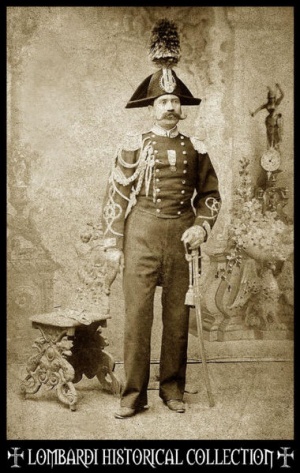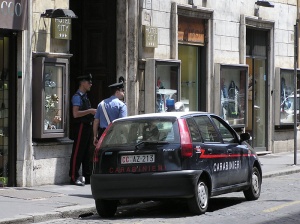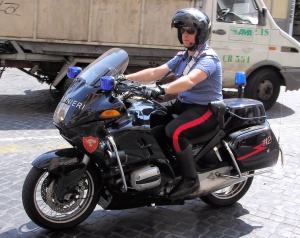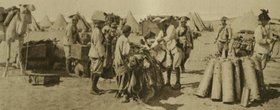Carabinieri
| Carabinieri | |
|---|---|
| Country | Italy |
| Type | Gendarmerie |
| Start | 1814 |
| Motto | Nei Secoli Fedele |
| Title | Comandante Generale |
| Head | Generale di Corpo d'Armata Gianfrancesco Siazzu |
| HQ | Rome |
| Web | Carabinieri online |
The Carabinieri are the military police of Italy. Because they police both military and civilian populations, they are a gendarmerie force. Carabinieri is Italian for Carabiniers, but the Italian word is used as the common name for this force in English. The full official title of the force is Arma dei Carabinieri (Force of Carabinieri).
Historically, a Carabiniere was a cavalryman or soldier armed with a carbine. Their motto is Nei Secoli Fedele (Faithful throughout the Centuries). Their mission was to control crime and to serve the community through respect for the Law.
History

The corps was created by King Victor Emmanuel I of Savoy, with the aim of providing Piedmont with a police corps similar to the French Gendarmerie. Previously, police duties were managed by the Dragoni di Sardegna corps, created in 1726 and composed of volunteers.
After French soldiers had occupied Turin at the end of the 18th century and later abandoned it to the Kingdom of Piedmont-Savoy, the corps of Carabinieri Reali (Royal Carabinieri) was instituted under the Regie Patenti (Royal Patents) of July 13, 1814.
Both a military and a police corps, the Carabinieri have fought in every conflict in which Italy has been involved, suffering heavy losses and being awarded many decorations for gallantry.
The Carabinieri are particularly proud of the memory of Brigadier Salvo D'Acquisto, who was executed by the Nazis in Palidoro, near Rome, in World War II, having exchanged his life for the lives of innocent citizens due to be executed in retaliation for the murder of a German soldier. Brigadier D'Acquisto falsely claimed responsibility and was shot for the offence.
The history of the Carabinieri recounts many such actions and the corps is nicknamed La Benemerita (the Meritorious).

The Carabinieri is now an armed force (alongside the Army, Navy and Air Force), thus ending their long standing as the first corps (Arma) of the Army (Esercito). It is likely that Carabinieri will continue to be referred to as the Arma by antonomasia.
In recent years Carabinieri units have been dispatched on peacekeeping missions, including Kosovo, Afghanistan and Iraq. In 2003 twelve Carabinieri were killed in a suicide bomb attack on their base in Nasiriyah, near Basra, in southern Iraq, in the largest Italian military loss of life in a single action since the Second World War (see 2003 Nasiriyah bombing).
At the Sea Island Conference of the G8 in 2004, the Carabinieri was given the mandate to establish a Center of Excellence for Stability Police Units (CoESPU) to spearhead the development of training and doctrinal standards for civilian police units attached to international peacekeeping missions.

Organisation
Chain of command
The corps is headed by the Comando, consisting of the Comandante Generale (a General), the Vice-Comandante Generale (a Lieutenant General) and the Headquarters Staff, all located in Rome.
Territorial organisation
The Carabinieri are organised on a territorial basis for law enforcement missions. There are five Zones (commanded by Lieutenant Generals), 20 Regions (commanded by a Major General or Brigadier Generals) and 104 Provinces (commanded by a Colonel or Lieutenant Colonels). At a local level, in medium-sized cities there are Companies, commanded by a Capitano (Captain), and in small towns there are Stations, commanded by a Maresciallo (which translates literally as "Marshal" but is equivalent in rank to a Warrant Officer).
Specialist Mobile Unit Command
Outside the territorial organisation, the Specialist Mobile Unit Command Palidoro based in Rome controls the Mobile Unit Division, Specialist Unit Division and the ROS.
The Mobile Unit Division
The Mobile Unit Division located in Rome has two brigades.
1st Mobile Brigade based in Rome consists of 11 battalion-sized regiments and the Carabinieri Mounted Regiment.
2nd Mobile Brigade situated in Livorno consists of the Tuscania Parachute Regiment located in Livorno, 7th Trentino Alto Adige Regiment and the 13th Friuli Venezia Giulia Regiment. The GIS (Gruppo di Intervento Speciale - Special Intervention Group) is also part of 2nd Brigade and is the Carabinieri's elite counter terrorism unit, similar to the British Special Air Service and the German GSG 9, and is composed exclusively of former members of the elite forces. It has the same training as the NOCS of the Polizia di Stato but has wider duties as the Carabinieri are also responsible for military policing so only the GIS is involved when military installations are under threat. It may also be sent abroad on peacekeeping or enforcement duties.
Particularly significant is the role the MSU (Multinational Specialised Unit) carries out in the Balkans. It bridges the security gap between the military and civilian police forces, either UN or local, both of whom are often not trained in public order operations. As a result of the experience the MSU has gained, the European Union has approved the institution of an Integrated Police Unit, which can be immediately deployed, flexible and inter-operational with the military to be used for humanitarian aid, peacekeeping and in natural disasters.
Specialist Unit Division
The Specialist Unit Division located in Rome consists of highly qualified personnel working for ministries to scrutinize socially sensitive issues. Sanitary Enforcement Task Force investigates hygiene violations in the processing, sale and distribution of foods and drinks. Environmental Protection Command is involved in protecting land, water and air against pollution, monitoring hazardous materials and protecting endangered plants and wildlife.
The Tutela Patrimonio Culturale or TCP protects Italy's cultural heritage and the Nucleo Tutela Patrimonio Artistico specialises in the protection of artwork and in the recovery of stolen paintings.
Other special task forces enforce agriculture and employment legislation, and provide security for the Foreign Affairs Ministry plus Italian and overseas diplomats. Very high-risk personnel are protected by members of the Tuscania Parachute Regiment. Bank of Italy Command is responsible for the escort of money transports and security and surveillance in all branches of the bank. Currency Anti-Counterfeiting Command is integrated into the Bank of Italy to identify and investigate the circulation of forged banknotes. Scientific Investigation Department conducts forensic investigation and research and develops modern techniques for investigative purposes. Helicopter Group guarantees national coverage with light and multi-purpose choppers with a response time of 30 minutes.
ROS
The ROS (Raggruppamento Operativo Speciale) is an elite unit founded in 1990 to deal with organised crime (Mafia and others), subversive activities, terrorism and the more complex types of crime. An anti-crime section is found in every city district public prosecutor's office.
Special Tasks Departments
Special Tasks Departments are outside the ordinary organisational framework and are attached to various departments and entities for the execution of specific missions:

Corazzieri (Cuirassiers) are an elite corps and honour guard of the President of the Italian Republic located in the Quirinale palace. They are distinguished by their uniforms and height (the minimum height for admission is 190cm, or 6 feet 3 inches). They have almost no other everyday duties, although they may be seen patrolling occasionally.
Other departments are in service to Constitutional Bodies such as the Presidency of the Republic, the Senate, Parliament, the Judiciary, the Prime Minister and the National Council of Economy and Labour.
Carabinieri also perform Military police and security duties for the Ministry of Defence, military high commands, offices of the military judiciary and allied military organisations in Italy and abroad. They also have personnel attached to the Department of Public Security in various departments as well as anti-mafia and anti-drug investigation task forces. Furthermore, Carabinieri officers are in charge of surveillance and security at Italian Embassies and Consulates abroad, performing the same services entrusted to the United States Marine Corps in US Diplomatic and Consular offices.
There are Carabinieri groups around the world including Australia and Canada.
The Carabinieri in Italian culture

Carabinieri made an appearance in Carlo Collodi's 1882 Pinocchio, when two officers arrest Pinocchio for a crime he has not committed.
While the Carabinieri have been widely considered one of the most trusted and competent institutions by the Italian population, they are also the traditional butt of many jokes implying that they were stereotypically incompetent and unable to think beyond blind obedience [1].
Many films and tv series have featured the Carabinieri, including as protagonists. Racconti del Maresciallo, La Tenda Nera, Il Maresciallo Rocca and Carabinieri are some of the titles that have been produced, mainly by the RAI fiction division.
In January 2005, the private television network Canale 5 introduced a Carabinieri-related drama series called R.I.S. based on the Ra.C.I.S. (Raggruppamento Carabinieri Investigazioni Scientifiche; Carabinieri Scientific Investigation Group) and modelled on the American CSI: Crime Scene Investigation.
Criticism

Although the Carabinieri have a very positive reputation among the Italian people, it is not to be neglected that in different hisorical periods they have been involved in atrocities, as part of the Italian African Police, in occupied Ethiopia in the late 1930s and early 1940s, during the fascist regime of Benito Mussolini the corps of Carabinieri cooperated with the regime because that was order of the king.
However, when King Victor Emmanuel III ordered the arrest of Mussolini on 25 July 1943, the Carabinieri were entrusted with this task. It is also noteworthy that, when Mussolini was freed by the Germans in September 1943 (following Italy's armistice with the Allies) and took the lead of the Repubblica Sociale Italiana in October 1943, he decided to disband the Carabinieri and establish in their place a new police force, the Republican National Guard (Guardia Nazionale Repubblicana – GNR). Although the GNR was largely constituted of former Carabinieri, this decision was probably due to the fact that the Carabinieri were traditionally considered as being closer to the constitutional monarchy than to the fascist regime, and therefore not fully reliable after the King had switched over to the Allies' side.
Some senior carabinieri were implicated in the controversies surrounding Operation Gladio, including the violent "strategy of tension" and an embryonic plan for a coup d'etat. These allegations remain unproven. The Carabinieri were criticised for their handling of the policing of the G8 Summit in Genoa in 2001, and the killing of a protestor Carlo Giuliani. Charges for the killing were later dropped.
See also
External links

